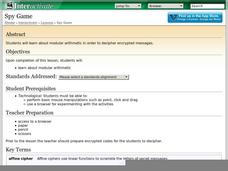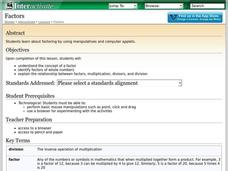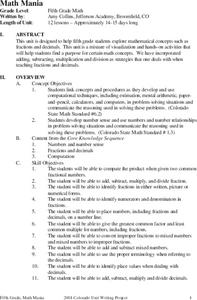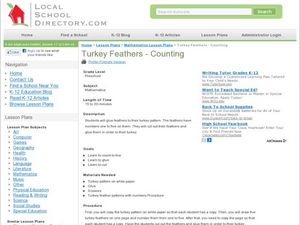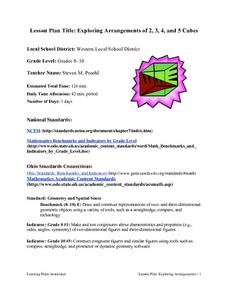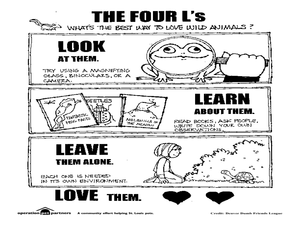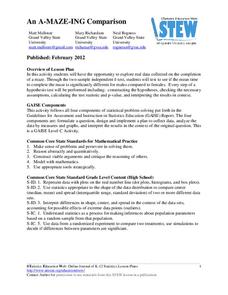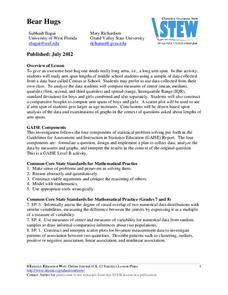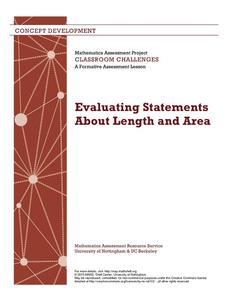Shodor Education Foundation
Spy Game
Turn students into detectives as they decipher encrypted messages. Introduce your class to modular arithmetic and have a little fun encrypting and decoding secret messages. The activity does not hit many content standards, but...
Curated OER
Factors
Practice factoring numbers by using graph paper, manipulatives and computer applets.
Curated OER
Objects Vibrate
Young scholars strike a tuning fork and dip it in water. They sprinkle cereal flakes on a drum, than tap the top of the drum. Students stretch a rubber band between two fingers and pluck it; stretch the elastic farther and pluck it...
Curated OER
Number and Number Relations: Lesson 2
Eighth graders recognize or compute decimal equivalents of fractions. They recognize or compute the percent equivalent of decimal fractions. They relate fraction, decimal, and percent equivalents and recognize decimal equivalents.
Curated OER
Math Mania
Fifth graders review adding, subtracting, multiplication and division of fractions and decimals through a variety of activities and exercises.
Curated OER
Turkey Feathers
Learners demonstrate counting skills. In this number sense lesson, students glue numbered feathers onto a turkey pattern in numerical order.
Curated OER
Exploring Arrangements of 2, 3, 4, and 5 Cubes
Young scholars construct models of various tricubes, tetracubes, and pentacubes that are possible, classify n-cubes into different groupings, and draw these figures on isometric dot paper giving true perspective to what they visualize.
Curated OER
Math: How Many Ways Can You Find the Middle?
Twelfth graders find the mean, median, and modes of stacks of Lego blocks, They search in newspapers for real life applications of them. They present oral reports on what they have learned.
Curated OER
Animals, Animals, Everywhere
Fourth graders participate in a variety of activities dealing with animal characteristics and classifications in this multi-task lesson. They use graphic organizers, make booklets, and make models.
Curated OER
I'll Halve S'More, Please!
Students describe a fraction in terms of sharing parts of a whole. They understand the meaning of the parts of a fraction and add and subtract like fractions. They apply fractions to problem situations and recognize and use equivalent...
Curated OER
Why is it so hot when I sit next to the window?
Learners investigate how energy travels through glass. In this energy usage lesson, students conduct an experiment in which they decide if window film affects how much energy travels through the glass. Learners use a journal to make...
Curated OER
Density Derby
Students explore the relationship between mass, volume and density. They use model boats to discover how changing mass and volume affect density. This is a very engaging instructional activity which provides great demonstrations and...
Curated OER
Wonderfully Wild Unit the four L's of Wildlife
Students appreciate the natural environment. For this "four L's" lesson, students observe, reflect and appreciate unique ecosystems and how they help sustain life. Students create posters with the four L's.
Mathematics Assessment Project
Solving Quadratic Equations
Scholars first complete an individual assignment using a quadratic equation to model the movement of a bus around a corner. Learners then discuss their solutions with classmates and analyze the provided sample responses.
Curated OER
Ratios, Rates, Percent and Nutrition
Examine food labels to determine percentage of fat and sugar to total calories with middle schoolers. Daily nutritional guidelines are discussed and learners will decide how well their foods fit into a healthy diet. In the provided...
Curated OER
Goldfish Addition and Subtraction
Engage in a hands-on addition and subtraction activity that is a wonderful tie-in with ocean studies. As the teacher, you will make up equations using construction paper and goldfish crackers.
Mathematics Assessment Project
Designing 3d Products: Candy Cartons
Wouldn't it be great to work in a candy factory? Learners get their chance as they first design a carton for a candy that meets certain requirements. They then examine and analyze nets and explanations in sample student responses.
Mathematics Assessment Project
Classifying Proportion and Non-Proportion Situations
Proportions, proportions, everywhere. Class members complete an assessment task solving problems involving proportionality. They then complete an activity classifying given situations as proportional or non-proportional.
American Statistical Association
An A-MAZE-ING Comparison
Teach your class how to use descriptive statistics through a hands-on data collection activity. Pupils collect their own data, calculate test statistics, and interpret the results in context. They compare male and female results, looking...
Mathematics Assessment Project
Calculating Volumes of Compound Objects
After determining the volume of various drinking glasses , class members evaluate sample responses to the same task to identify errors in reasoning.
Mathematics Assessment Project
Building and Solving Linear Equations
Young scholars write and solve linear equations in one variable based on descriptions of the operations that are applied to the unknown variable in an algebra machine. They then create their own problems for classmates to solve.
American Statistical Association
Bear Hugs
Scholars research arm span to determine who gives the best bear hugs. They use data from a national study to find the standard statistics for arm span. It includes mean, median, quartiles, spread, standard deviation, and more.
Mathematics Assessment Project
Discovering the Pythagorean Theorem
Young mathematicians join the ancient order of the Pythagoreans by completing an assessment task that asks them to find the area of tilted squares on dot paper. They then look at patterns in the squares to develop the...
Mathematics Assessment Project
Evaluating Statements About Length and Area
Class members complete an assessment task by identifying whether statements about triangles and quadrilaterals are always true, sometimes true, or never true. They then participate in a sorting activity with the same objective.
